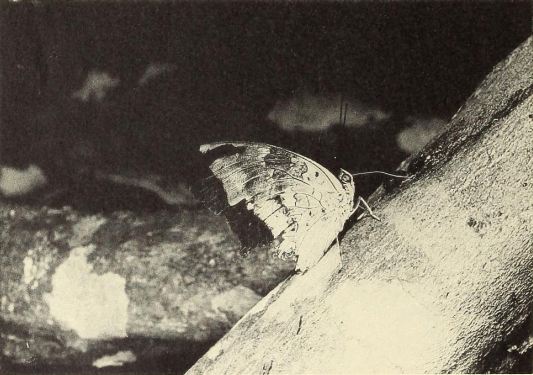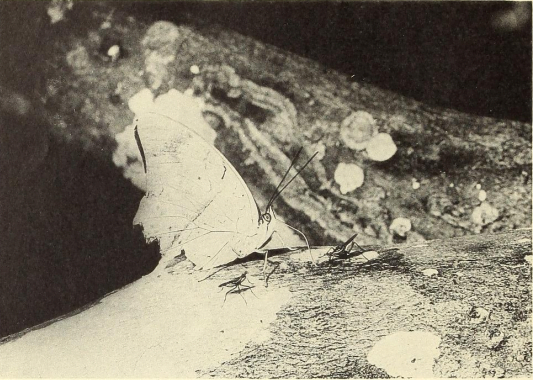III. Tangerine Association
On March 6 and on two successive days I observed a Cacao Caligo, Caligo eurilochus minor Kaye, resting on a particular spot on the branch of a tangerine tree, a citrus. Citrus nobilis Andre, whose fruit is otherwise known as portugal or mandarin orange. The tree was one of a row in the citrus grove on Water Trail, a few yards to the east of Simla Laboratory. The insect was unusually fearless and permitted close observation. It was busily probing with its tongue in a small area of what looked like the exudate of a spittle insect.
Subsequent observation and consultation with Dr. Egbert Tai of the Government Agricultural Experiment Station tentatively identified the puddle of white foam as probable evidence of the Crotch Disease of tangerines. Of this malady it is said that the cause is not known but a virus is suspected. One of the most conspicuous symptoms is a white froth, which may ferment, and oozes from openings in the bark. From time to time there may be a rehealing. Examined under a hand lens, bubbles are seen to surge up from below, burst, and their place taken by others. Except for these little scattered lesions the disease seemed no detriment to either blossoms, fruit or foliage of the trees under observation.

On the branches of two adjacent tangerine trees there were several small areas of the pale exudation. These seemed to bubble and to overflow at times, and again in temporary drought they dried up. At all times they were sources of intensive attraction to certain insects. As in fedegoso, the attractive agent was strongly and definitely selective.
A. Lepidoptera
In the course of several weeks of intermittent watching I observed fifteen species of butterflies alighting at one or the other of three small areas of bubbling froth, small puddles not more than one-half by one inch. I bored holes through the bark and wood, and daubed sugar and honey on the trunks, but failed to distract the attention of the insects from their chosen ambrosia. Seldom did a butterfly alight on the trees except within tongue’s reach of the froth. On the occasions when this did happen, there was instant approach to the attractive substance.
The fifteen butterflies were distributed among three related families, Nymphalidae, Morphidae and Brassolidae, in the proportion, of known Simla species, of 33%, 100%, and 60%. Although few in number of species, this group nevertheless included the largest and, in color and pattern, the most striking of Trinidad’s tropical butterflies.
The following is a list of the species of Lepidoptera observed at the tangerine feeding lesions, together with a few casual notes.
The large, Green-checkered Nymphalid, Victorina steneles steneles (Linnaeus), joined the tangerine association three times. One marked individual returned repeatedly for a week. When feeding it kept its wings closed, not flattened in the normal position of sunning. Also it confined its visits to the sunniest, warmest parts of the day.
Peridromia arethusa (Cramer), the Bluespotted Black, visited the trees day after day, singly, or a pair at a time. They alighted in an inverted position, with wings flat against the bark. If at a distance from the froth, they approached by runs or short spurts, with a single flap of the wings at beginning or end. Occasionally a histerid beetle would push beneath the wings, causing a momentary flapping but not distracting the insect from its feeding. Once a Colobura alighted on the flattened wings, sending the insect into flight, but the Blue-spot returned and in turn drove away its annoyer.

The Red-banded Hindwing, Biblis hyperia (Cramer), is common about Simla but a rare visitor to the tangerine trees. Twice it was seen feeding on the froth, like Peridromia alighting upside down, with flattened wings.
On April 3, an individual of the Six Orangespot, Catonephila numilia Cramer, came to the bait.
This was a new record for Simla and Ariraa Valley. Two others were seen later.
The Zebra Clicker, Colobura dirce dirce (Linnaeus) , was the only member of the tangerine group to be found commonly in the general vicinity at all times. During the present period of watching, from two to eight individuals were present at the bubbling areas. They had a regular flight routine, a quick, whirling dash, followed by a swoop to the bark of the nearest tree, alighting inverted, with closed wings. They often progressed by a series of short, quick runs over the branches. Zebra No. 1 had lost a full fourth of wing area, yet flew well. It was present on the first day, March 6, and on the last, May 18, the same individual was seen feeding while perched on the wing cases of a large, brown, eyed-elater. This butterfly was among the most persistent in pushing aside the beetles and flies which interfered with its feeding. It not only pushed but slapped with sideways flicks of its tongue, to obtain for itself free access to the froth.
A medium-sized leaf -brown butterfly haunted the tangerines for a week before I could capture and identify it. It proved to be Anaea morvus morvus (Fabricius) deserving the vernacular name of the Tailed Pygmy Morpho. On alighting its wings snapped together and it became as much of a stemmed, dead leaf as any Kallima. Above, it was conspicuous, the proximal half of the wings iridescent morpho blue, the remainder black with two anterior, small, blue spots. This was the second specimen to be taken at Simla.
